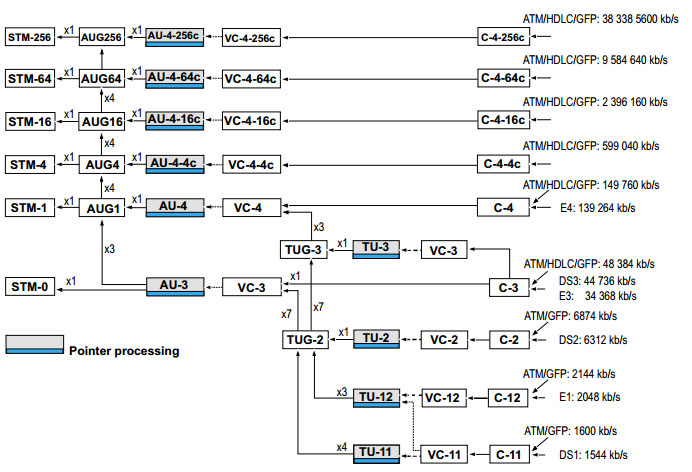SDH stands for synchronous digital hierarchy. SDH is the synchronous technology used everywhere except the US, Canada and Japan. Development of this international counterpart to SONET began a few years after SONET. The differences between SONET and SDH are based primarily on the different asynchronous bit rates that must be mapped into them. In developing these two technologies, there was a need to integrate existing transmission techniques in order to enable network operators to gradually introduce SONET and SDH.
SDH is used throughout the world except in the USA, Canada, and Japan, where they use synchronous optical network (SONET) transmission technology specification – the SDH equivalent which began in the USA during the mid 1980s. SONET has a base bit rate of 51.84 Mbps and is designated STS-1 (synchronous transport signal). When a bit rate is transmitted over an optical cable system, the signal is designated as OC-1 (optical container). Table 2 details the SONET and equivalent SDH signals and their associated bit rates in the hierarchy.
Because the highest-order commonly used multiplex signal in N.A. is 45 Mb/s, 51 Mb/s was a sufficient synchronous primary rate for virtually any SONET application. However in the rest of the world, where 140 Mb/s mux signals are very common, 155 Mb/s (STM-1) was chosen as the primary synchronous mux rate. This bit rate is exactly the same as the STS-3 or OC-3 bit rate.

Figure 9 gives an overview of the mappings currently possible according to ATM mapping and ITU-T recommendation G.707. Note the so-called sub-STM or STM-0 signal interfaces that are used in SDH/SONET links, radio links, and satellite connections. The STM-0 has a bit rate of 51.84 Mbps.
The hierarchy levels shown in Table 2 closely match the plesiosynchronous bit rates commonly used in these countries. Of all the levels listed, only STS-1, OC-3, OC-12, OC-48, and OC-192 are currently used.
Table 2 also indicates there are points where transition between SDH and SONET systems are possible. Matching is relatively simple, as gateway issues were considered during the development of SDH. Only minor adjustments need to be made to certain overhead bytes. However, SONET terminology is quite different; for example, the packing unit is referred to as a virtual tributary (VT-n) rather than a virtual container (VC-n). Figure 10 shows the SONET multiplexing scheme.

These hierarchy levels basically match the plesiochronous bit rates commonly used in these countries. As the table indicates, there are points where transition between SDH and SONET systems are possible. Matching is relatively simple, as gateway issues were taken into consideration during development of SDH. Only minor adjustments need to be made to certain overhead bytes. SDH terminology is however, quite different with the packing unit for example referred to as a virtual container (VC-n) as opposed to virtual tributary.